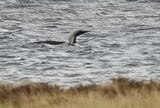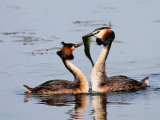Divers & Grebes
Divers
A small family of large water birds, with three species regularly seen in the UK (two of which breed) plus one rare vagrant from northern Asia (the white-billed diver). There is another similar species (the Pacific loon) in North America. All have long, slender bodies, moderately long necks and dagger-shaped bills, quite long but narrow wings and small legs (with long, lobed toes) set far back on the body. They are expert swimmers and divers but unable to stand or walk on land. All are migratory, breeding on freshwater lakes and pools but moving to the sea coast in winter.
For more information click here
Grebes
Small to medium-sized water birds, characterised by their pointed bills (long and dagger-like in larger species), round bodies, tiny tails and legs set far back on the body. The legs are flattened and the toes have broad, leaf-like lobes, so that the forward stroke underwater has minimum drag but the backward stroke can exert maximum pressure for forward movement. They are expert swimmers and divers but unable to walk on dry land. They build floating nests anchored to aquatic vegetation. Many other species are found almost worldwide.
For more information click here
Text (c) RSPB, used with permission
A small family of large water birds, with three species regularly seen in the UK (two of which breed) plus one rare vagrant from northern Asia (the white-billed diver). There is another similar species (the Pacific loon) in North America. All have long, slender bodies, moderately long necks and dagger-shaped bills, quite long but narrow wings and small legs (with long, lobed toes) set far back on the body. They are expert swimmers and divers but unable to stand or walk on land. All are migratory, breeding on freshwater lakes and pools but moving to the sea coast in winter.
For more information click here
Grebes
Small to medium-sized water birds, characterised by their pointed bills (long and dagger-like in larger species), round bodies, tiny tails and legs set far back on the body. The legs are flattened and the toes have broad, leaf-like lobes, so that the forward stroke underwater has minimum drag but the backward stroke can exert maximum pressure for forward movement. They are expert swimmers and divers but unable to walk on dry land. They build floating nests anchored to aquatic vegetation. Many other species are found almost worldwide.
For more information click here
Text (c) RSPB, used with permission



